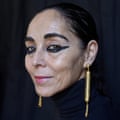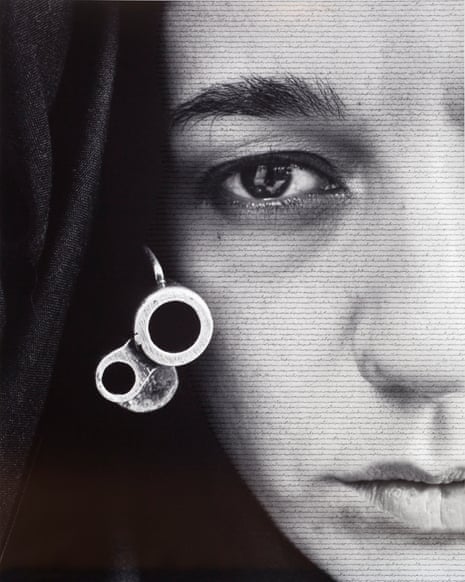This is my friend and muse, an artist called Arita Shahrzad. When it comes to capturing nuance and sadness, she has the perfect lips and eyes. I don’t actually take the pictures I produce. I’ve used photography for a long time, but I’m not technically trained. My role is more conceptual. I do the composition, the framing, the post-production and calligraphy. I’ve also posed in several pictures. It’s not like I get a cameraman in to do it all.
This image of Arita is taken from my Women of Allah series. It explored martyrdom in relation to women in the Islamic Republic of Iran. I’m fascinated by how martyrdom was encouraged and institutionalised during the 1979 revolution. It has deep political ramifications, but I also wanted to explore the psychological effects of martyrdom. These Iranians were caught between self-sacrifice, devotion, love of god – and cruelty, violence and death. We often think of women with an Islamic background as being passive and submissive to men, but here they were really empowered by bearing arms.
Women of Allah is supposed to be sympathetic, but also disturbing. Every image tried to frame that paradox: the woman who gives birth, is attractive and believes in God, but is also very brutal, very violent, a killer. I experimented with many poses – woman with a child, in decorative veils – but in every one she had a gun. I must have made about 80. What I like about this one, called Speechless, is that the weapon looks like jewellery, but it’s targeting the viewer. It’s usually printed larger than life so when someone stands in front of it, the gun points straight at their stomach.
At the time we shot this, I didn’t have a big artistic career: I was just having fun with the women. They weren’t real guns. I would rent them from theatrical suppliers. We shot on film, so things like light were really important, because the setup was so basic. There were imperfections, even in the final prints, because everything was so primitive. But we didn’t mind.
While the series did have a journalistic element, I wanted to push the conceptual side, even make it surrealist. I’m very interested in the use of calligraphy and decorative motifs in Islamic art. So I’d take a motif from, say, a Persian carpet and use that in a photograph. In every shot, you will find just the sort of repetition, abstraction, symmetry and composition that’s innate to classical Islamic art.
The lines you see across Arita’s face are verses by the Iranian poet Tahereh Saffarzadeh, in which she addresses her brothers in the revolution, asking if she can participate: “O, you martyr / hold my hands / I am your poet / I have come to be with you / and on the promised day / we shall rise again.” I wrote them out by hand. The meaning of those words, combined with the beauty of Arita’s face, is disrupted by the violence of the weapon.
Shirin Neshat’s CV

Born: Qazvin, Iran, 1957
Educated: University of California, Berkeley
Influences: “My extreme nostalgia for Iran, but also Cindy Sherman and Frida Kahlo.”
High point: “Having my work bought by Cindy Sherman.”
Low point: In 2002 I got really exhausted. I felt like I’d become a servant to collectors and the market.”
Top tip: “Art comes from experience of life. You have to go out there and live.”

Comments (…)
Sign in or create your Guardian account to join the discussion